A few days ago a fellow shaver posted a thread on my favourite shaving forum, asking for information on something called the Buddy Kit. And since Bax included a photo with a patent number… well, you know what I had to do. So to the Internet I went, and started digging.
The patent application for the Buddy Kit was filed in mid 1941. It was almost two years before it was granted though, possible due to things getting a little hectic at the end of ’41. There was a war on, after all – which may explain an oddity I’ll get back to.
It is slightly puzzling to me that Mr Norman N Glickman opted for a utility patent, and not a design patent. Not only are a full patent harder to file, but they are also more costly to maintain. Possible explanations is that Mr Glickman wanted to make multiple claims, or he wanted a longer protection period.
The patent
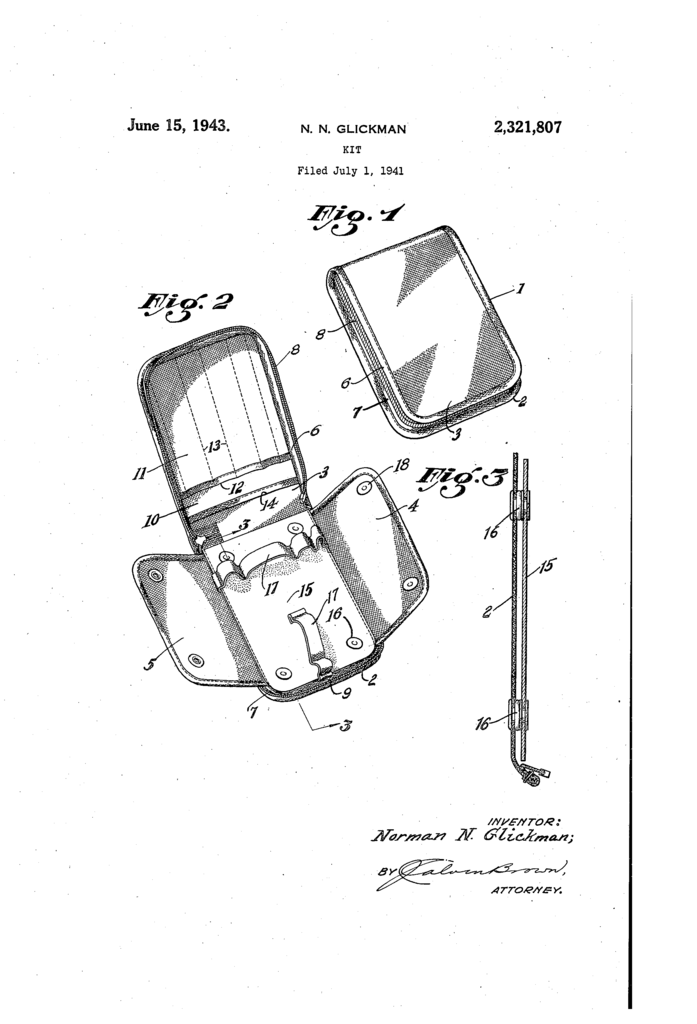
As one can see from the drawing, the kit itself is not earth shattering. I severely doubt that it was particularly innovative, given that things like the ComfyKit had been offered more than two decades before Mr Glickman filed for a patent. Where the Buddy Kit excelled over the earlier kits were size. According to the patent it should fit in a hip or breast pocket without undue bulkiness. And while something like the Khaki Kit (or a modern recreation) would be even less bulky, the Buddy Kit was significantly more complete.
The claims of the patents were not overly broad, but neither very specific. To quote:
A kit of the character disclosed including a single piece of flexible material adapted to be folded transversely on a medial line to form a back and cover, marginal edge flaps for the back and cover adapted to be connected by slide fasteners to form a closed receptacle, a plurality of pockets formed on the inner face of the cover, an article holding base of approximately the same size as the back detachably secured to the inner face of the same and having article retaining straps on its inner face, side flaps on the back adapted to overlie the article holding base, detachable securing means on said flaps to connect the articles in place, and said article holding base being formed of relatively stiff material to prevent distortion of the flexible back and cover when the kit is closed.
From US patent 2,321,807
In short, Mr Glickman asked for a patent covering the way the kit was shaped from a single piece of stiff material. He did not ask for a patent covering the content or layout of the kit.
Photos by Bax
Let us have a look at the photos that Bax posted, and graciously let me use. They make a great overview of the content of the Buddy Kit.
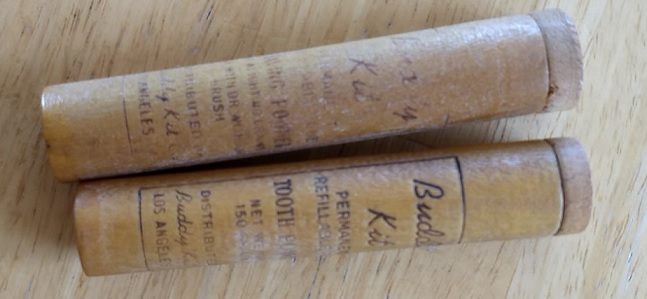
Refillable tubes for soap powder and tooth powder 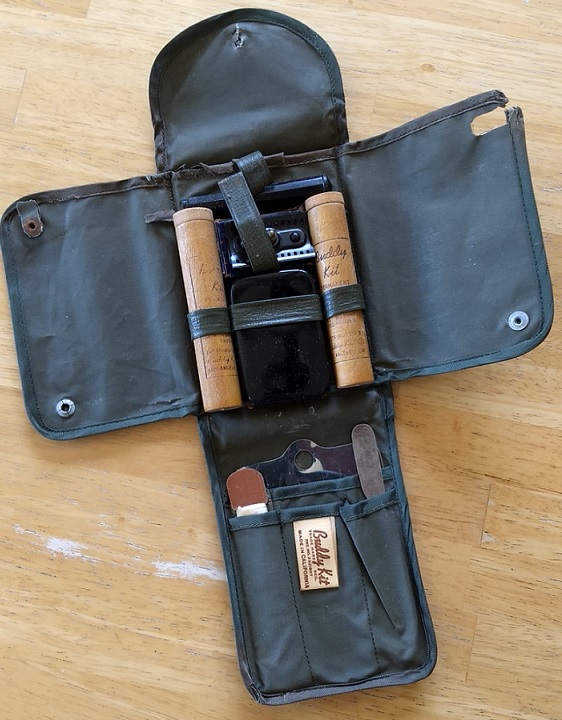
Buddy Kit all packed up 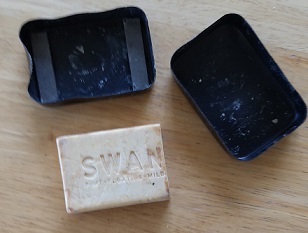
Soap cup with soap 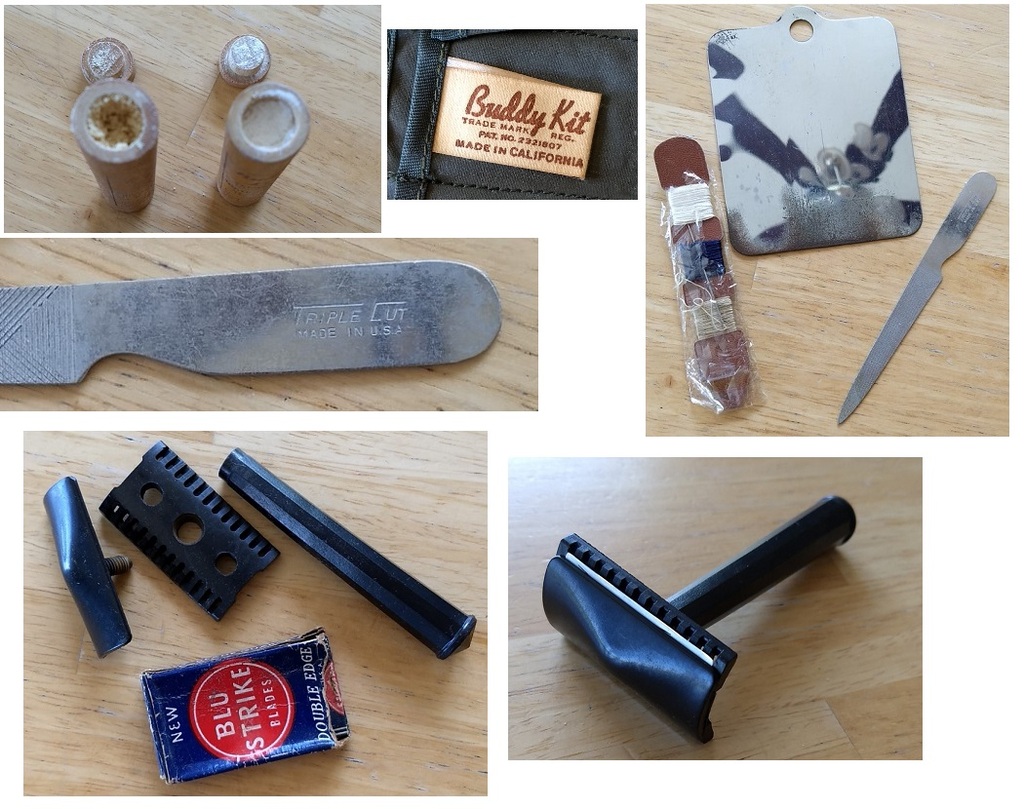
The parts of the buddy kit, outside the holder
In addition to a razor and blades, the kit seem to have come with a mirror, shaving soap, tooth brush and tooth powder, soap, thread and needles, a nail file, a comb, and possible more. The soap and tooth powders were in refillable containers. Everything a soldier or sailor need… but also everything a hunters, scouts, hikers, campers, and others would find useful.
There is also a second variation of the Buddy Kit you can find online. It is without the side flaps, but has a pouch to place the folded kit in. This is possible an earlier variation, since those kits are marked “Patent Pending”.
Final thoughts
The patent don’t seem particularity geared towards the military. I find this odd considering the Buddy Kit is often presented as martial in nature.
A lot of the Buddy Kits I’ve seen on eBay, Worthpoint and elsewhere claim either a military provenance, or to be World War Two or Korean War issue. For example, the kit that Bax shared on the ShaveNook apparently saw service in Korea. Oddly enough there is no military stamps or marking anywhere on the kits. And we know that the US Army, US Navy and US Marine Corps marked almost everything they handed out as standard issue.
I have given this discrepancy some thought, and I do believe I have found the likely explanation. Given the fairly low numbers I can find online, the lack of any markings beyond manufacturers marks, and the relative large amount of things in the kit leads me to believe this was not a standard issue set. The kit may have been a substitute standard, or it was offered for sale in the commissary or post exchange. This would explain both the lack of markings and the known provenance.
You can read the full text at Google Patents, and if you enjoy this sort of thing I have a lot of similar posts on my blog.
